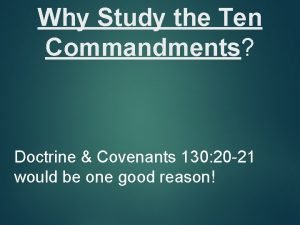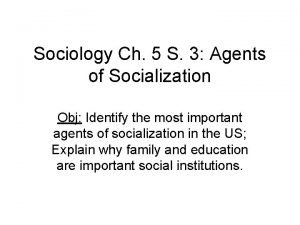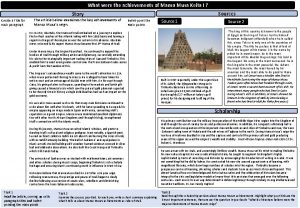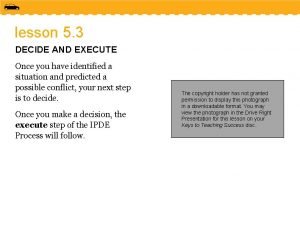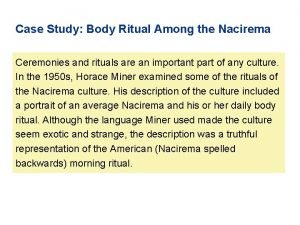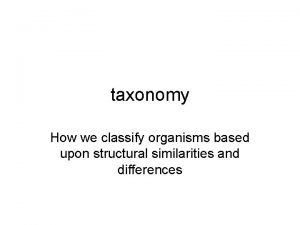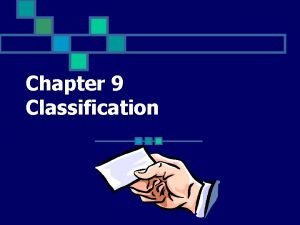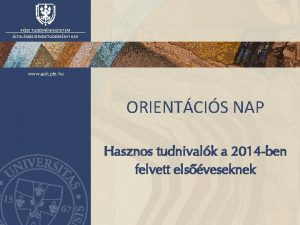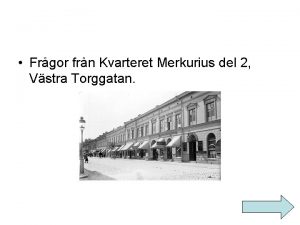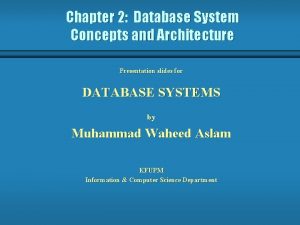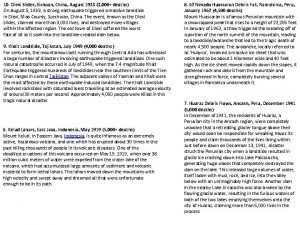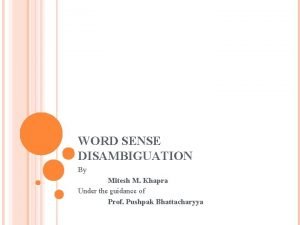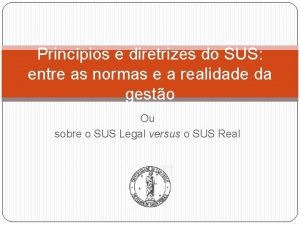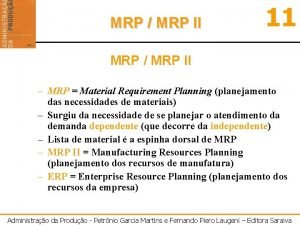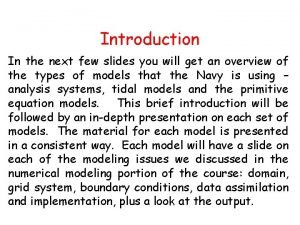Rafa Wojciechowski European Legal History Most important slides


























































































































































































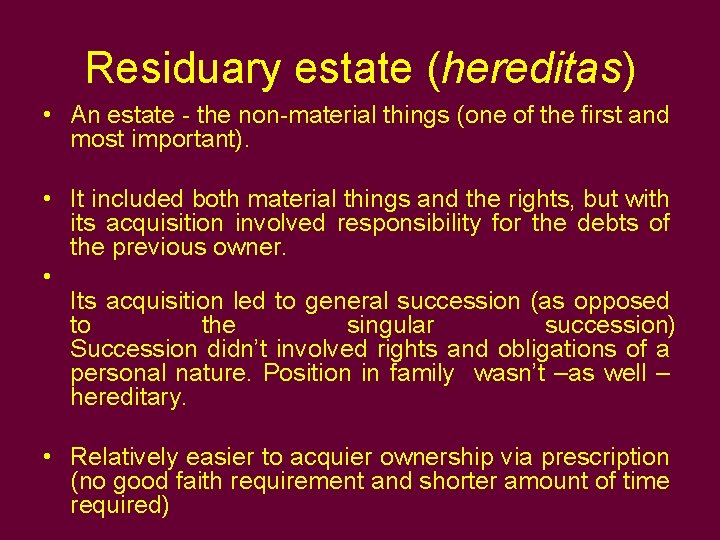
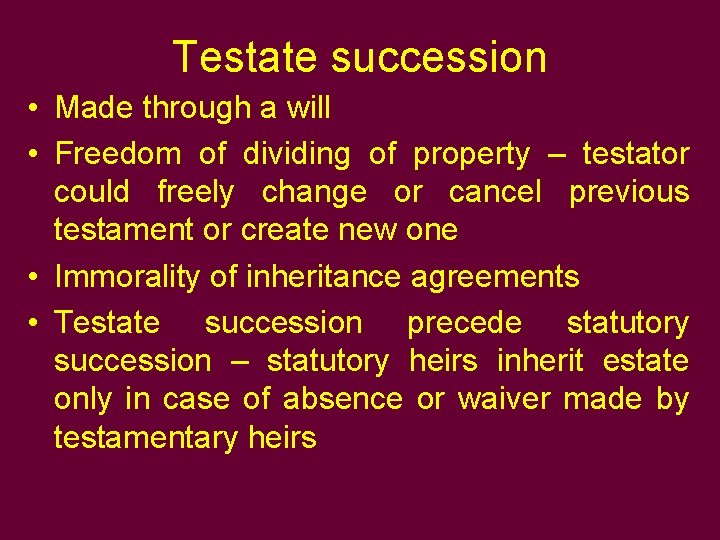
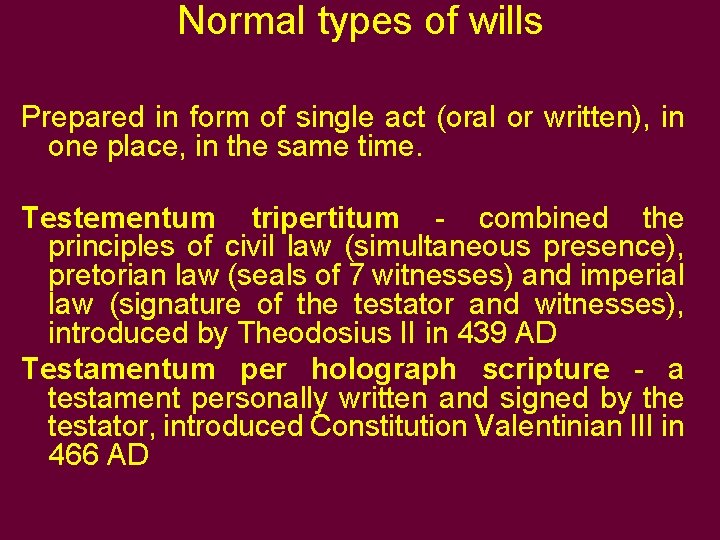


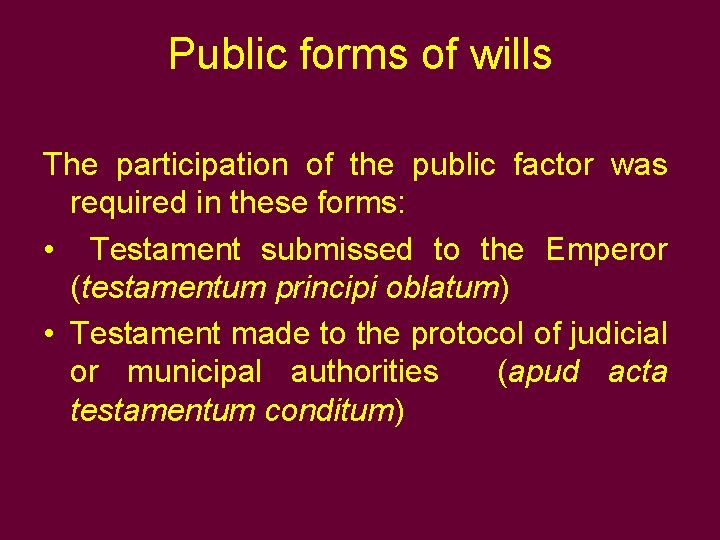
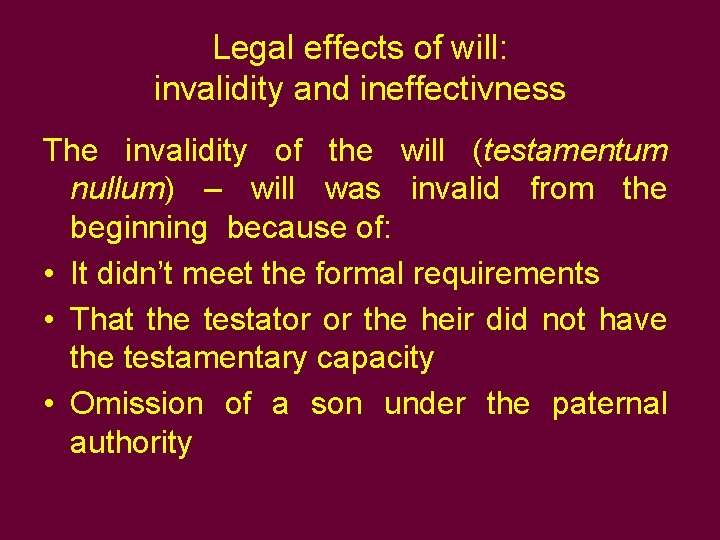
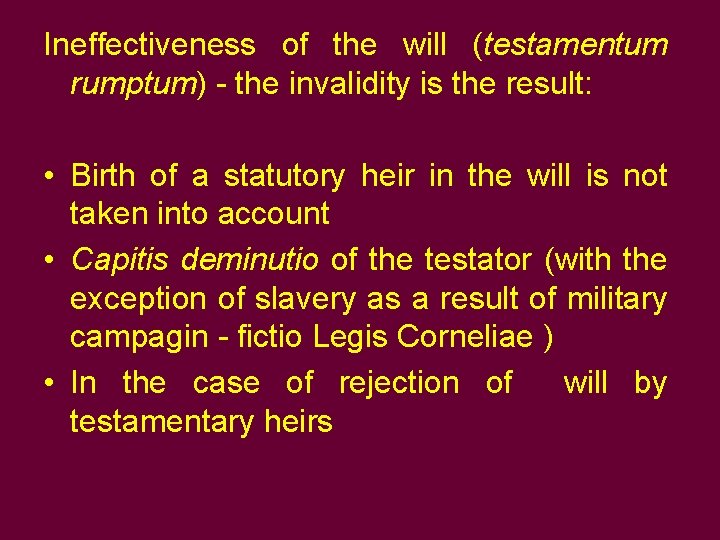
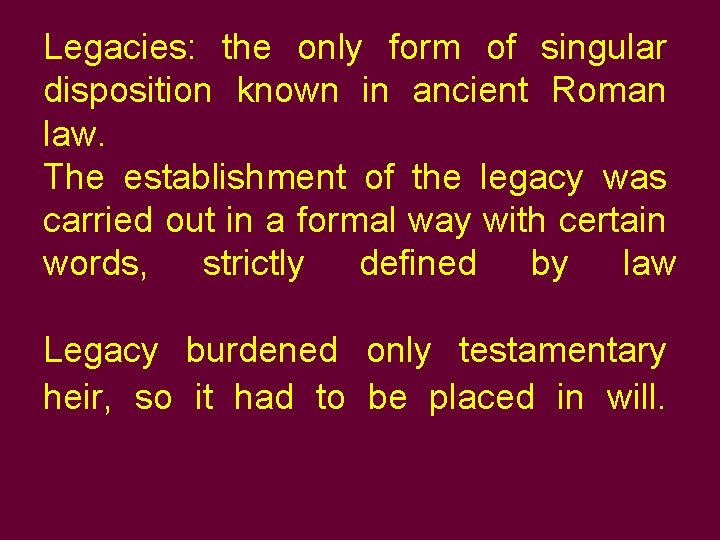

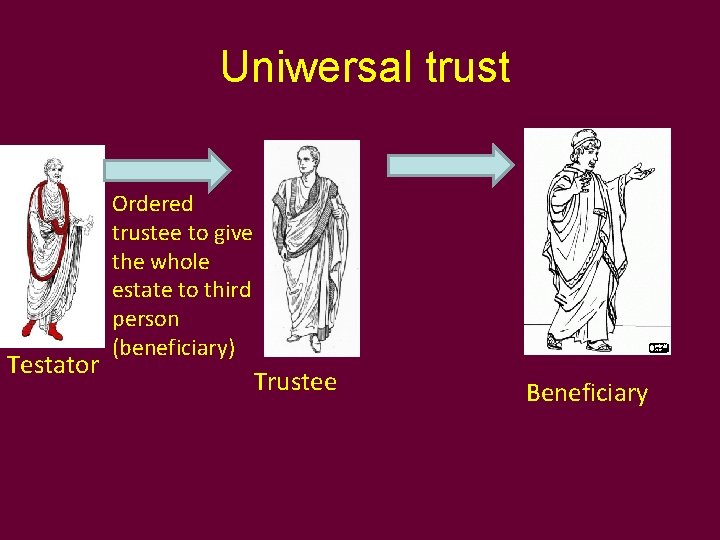
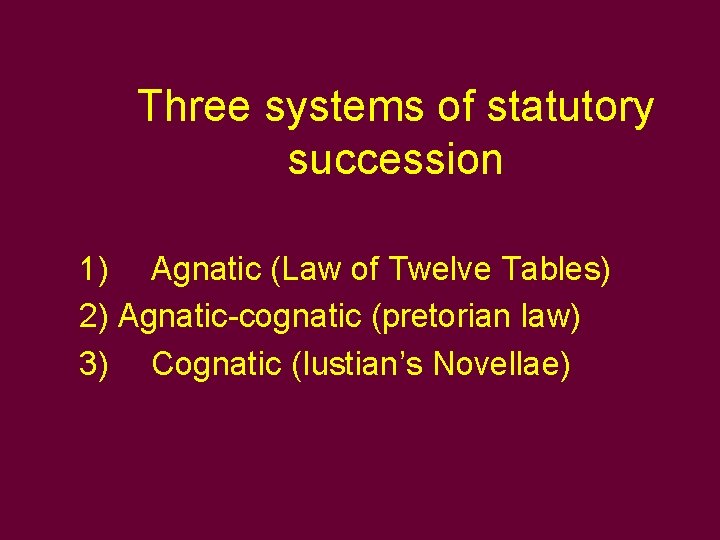


- Slides: 200

Rafał Wojciechowski European Legal History Most important slides

Egypt Around 3100 BC the pharaoh Menes united Lower and Upper Egypt and began the process of constructing a unitary state. The status of the Egyptian ruled evolved: the king was first regarded as a god, then the son of a god, and then as an intermediary between the gods and the people. The monarch was a despot, holding legislative, executive, judicial and military authority all at once. Submission to this authority was considered fulfilling the will of the gods, and rebellion was punished by the most severe temporal penalties as well as condemnation in the afterlife.

Egypt 2 The will of the ruler was carried out by state administration. It was headed by the Vizier, the pharaoh’s deputy. The chancellor and chief treasurer were under his authority. Local administration was based on a division into nomes, ruled by nomarchs. Their function was taken from local rules of previous times. They concentrated administrative, judicial and fiscal authority, and oversaw local economic management. Nomarchs oversaw lower-ranking bureaucrats, who primarily managed public works. Public administration workers were paid in kind.

Mesopotamia Kings ruled the states in the land between the rivers. In the third millenium BC they were generally considered incarnations of the main gods. In the second millenium they were only seen as the earthly representatives of the gods. The kings were primarily aided by civil servants known as nubands, who were responsible for managing the royal court, day-to-day affairs of state and for exercising power over the military.

Mesopotamia 2 A centralized administration in Mesopotamia came about during the Babilon era of the 18 th century BC. Hammurabi divided the state into provinces with governors (issaku) at their head, then into districts with satraps (pahatu). The smallest unit was the commune, headed by the warden (rabianu). Local civil servants joined administrative, police and judicial functions. The king directly appointed civil servants on all levels.

The Jewish state In the Jewish state the king was never regarded as a godly being, but rather only as anointed. The king oversaw the executive power. Lawmaking power belonged to the assembly, which limited the monarch’s despotism. Central administration rested in the hands of clan leaders.

The Jewish state 2 The Jewish state was divided into 12 districts, a reference to the tradition of the 12 Israeli tribes. The head of a district was known as the judge. Every district was required one month out of the year to deliver supplies to the palace needed for maintaining the royal court. After the death of Salomon, around 930 BC the Jewish state disintegrated into the Kingdom of Judah (two tribes in Jerusalem) and the Kingdom fo Israel (10 tribes occupying Samaria).

Greece Around 1200 BC, Greece was occupied by the Dorians. They led to the fall of the Mycenaean culture. This new situation did not lead to a unified Greek stat. However, small state-like bodies developed called poleis (Latin singular polis). Polis consisted of both a city and its surrounding area. Usually the territory of a polis amounted to several hundred km 2 and anywhere from a few thousand to tens of thousands of residents. Athens (2, 500 km 2) and Sparta (8, 400 km 2) were exceptions.

Athens At the beginning a king was the head of the state. His power was quickly restricted. As early as archaic times the kings were elected, first for 10 years, then for only one year. Royalty in its early form disappeared from Athens in the mid-7 th century BC. One of the archons then received the title of king (archont basileus) in order to carry out religious functions. Only aristocrats were eligible to assume this prestigious function.

Athens 2 The most important civil servants in Athens were archons. They were instituted in order to limit the power of the king. The first one appinted was the archon polemarch to lead the army, then the archon eponymous responsible for internal state affairs. They were initially appointed for life, then for a period of 10 years, and from 683 BC for one year. Around the mid-7 th century, six new civil servants were appointed, thesmothete. They were considered archons. There were a total of 9 archons, and their leader was the archon eponymous.

Athens 3 The Areopagus was the Athenian council of elders. Tit was composed of previous archons who had compelted their year of service. The Areopagus was led by the archon basileus. The Areopagus’s powers included adjudicating the most serious crimes, oversight of administration and the appointment of new archons. The development of Athenian democracy in the mid-5 th century BC led to the Areopagus losing most of its administrative powers.

Athens 4 During the oligarchic governments in Athens, some administrative advisory powers exercised by the Areopagus were taken over by the Council (boule), composed of around 400 members selected by territorial units. During the Athenian democracy, the primary administrative authority was the Council of 500. Every full citizen 30 years of older could become a member. The Council’s term of office lasted for one year and it was possible to be selected for membership a maximum of two times.

Athens 5 The Council of 500 met every day except for holidays and during ill-omen days. It was divided into 10 tribes with 50 members each. An Athenian year consisted of 10 months, so every division had to perform its function for one month. The months were selected randomly. Members of the Council were referred to as prytans, and their term of office was called a prytanie. A president was selected at random every day, who was in office for the entire with a portion of the prytanies. He was entrusted with keys to the treasury and the archive.

Athens 5 Many other civil servants were appointed, generally by random selection. It is estimated that in democratic Athens the number of state offices was around 800. Officeholders were entitiled to a salary and many privileges. They wore a wreath of myrtle when performing their office. In the 5 th century BC, the old archons were replaced in offices by strategists. There were 10 strategists. They were selected by a vote during a general assembly. They led the army, which was why they were neither appointed by drawing lots nor limited to a term of office. Pericles held this office in the years 443 -429 BC.

Sparta The Spartan state was ruled by two kings. Initially elected, over time they became hereditary. Their power was progressively limited. The most important civil servants were ephors. Beginning in the 5 th century BC, rulers had to swear an oath by which they obliged themselves to respect the law. There were five ephors, and they most likely represented the five settlements that made up Sparta. From the 6 th century BC they were elected by citizens for a one-year term. They were entrusted with administration, foreign policy and judicial authority. They had the right to convene the assembly (apella).

Sparta 2 Two ephors accompanied a king during military campaigns and observed his behaviour, but they did not have the right to issue orders. After returning, they filed a report in which they could bring charges against the king. The court was composed of the second king, the ephors and members of the council of elders. Punishment consisted of death, banishment, dethroning or a fine.

Sparta 3 The council of elders in Sparta was called the Gerousia. According to tradition, it was first convened in the 8 th century BC by the king Lycurgus, the legendary lawgiver of Sparta. It was composed of 2 kings and 28 gerons who were appointed for life by the assembly (apella). The Gerousia’s powers included ruling on the most important matters of state, judicial powers in the most important criminal matters, preparing draft resolutions for the assembly and rescinding resolutions of the assembly that were detrimental to the state’s interests.

The Roman Kingdom It is traditionally accepted that Rome was founded by Romulus in April of 753 BC. The beginnings of the Roman state (civitas) was the settlement of the Palatine Hill, whose first residents were the Latini. Around the 6 th century BC they united neighbouring villiages, creating the Septimonium, i. e. The city on seven hills. According to tradition, Rome was first ruled by seven succesive kings, beginning with Romulus and lasting through Tarquinius Superbus, who was banished in 509 BC.

The Roman Kingdom 2 The first and the last kings were certainly elected. Some of the others may have been hereditary. The king was selected by the Curiate Assembly. The king exercised supreme executive, judicial, military and religious authority. Legislative authority was limited by the powers of the Curiate Assembly. Civil servants were appointed and dismissed by the king. The Senate was a council of elders with advisory powers. Initially there were 100 of them, and at the end of the Kingdom they numbered 300. In the event of an interregnum, the Senate appointed successive interreges until a new king was chosen.

The Roman republic The republic was founded in 509 BC. The aristocracy that was introduced was then later transformed over two centuries of battles between the plebians and the patricians into oligarchy. The expansion of Rome to cover all of Italia began in the 5 th century BC and lasted until the beginning of the Punician Wars in 264 BC, when Rome began its expanssion into other areas of the Mediterrenian Sea basin. At the end of the 2 nd century BC, the Roman republic was engulfed by internal conflict that slowly turned into a civil war in the 1 st century BC. This led to the transformation of the republic into an empire around the year 27 BC.

The Roman republic 2 The magistratus designated both the civil servant and the office itself. Magistrates were divided into higher (maiores) and lower (minores). Magistrates were selected at popular assemblies called comitia. Higher officers were consuls, praetors and censors. Lower officers were aediles, questors and others given specific tasks. All officers were entitled to potestas, the right to issue edicts and assess penalties for not adhering to them.

The Roman republic 3 Civil servants also wielded the imperium, the right to command army, exercise judicial power and to summon popular assemblies. All magistrates, with the exception of dictator and censor, shared these characteristics: • Elected by assembly • Collegiality (at least two people) • Fixed terms of office (usually one year) • Honorary position with no salary • Responsibility before the popular assembly • Civil and criminal liability

Roman republic 4 Consuls held military and administrative powers, as well as some legislative and judicial ones. With time, the latter two were taken over by praetors. Official documents were signed with the names of two consuls in Rome. In the 1 st century BC, they were assigned the governance of a province and given the title of proconsul after their yearly term of office expired.

Roman republic 5 The office of municipal praetor was created in 367 BC. He exercised the power of iurisdictio, meaning he ruled on the law relevant for resolving a given court dispute. He then handed the case over to a judge, who examined the facts of the case and gave a verdict.

Roman republic 6 In 242 BC the office of praetor peregrinus was established. He wielded the power of iurisdictio in cases involving foreigners, as well as those between foreigners and Roman citizens. At the beginning of his term the praetor issued an edict detailing the principles under which he would perform his duties of office. After their term of office was compelted, they were given the title of propraetor and took a position in governing the provinces.

Roman republic 7 The office of censor was established in 443 BC. Two censors were selected by the assembly for a period of 5 years. Their primary function was to maintain a record of citizens and to estimate their fortunes (census) for the purposes of raising armies and assessing taxes. Censors also supervised morality in public and private life. Those considered to be undignified could be punished with so called „censorial remarks” (nota censoria). They reviewed the lists of senators (lustrum), and crossed off the names of the undignified. Censors also exercised oversight of the public purse and public procurment.

Roman republic 8 The dictatorship was an extraordinary office. The dictator was appointed by the consul based on a resolution of the senate. The first dictator was appointed in the 5 th century BC. His term of office lasted 6 months. The last dictator in the classical republican sense was appointed in 202 BC. There was no appeal against the dictator’s judgements to the popular assembly, unlike in the case of judgements from other public servants. In the 1 st century BC the office of the dictator took on a different nature and was the foundation of the power of such exceptional individuals as Sulla (8279 BC) and Caesar (48 -44 BC).

Roman republic 9 Tribunes of the Plebs, first 2, later 5, and finally 10 were selected annually at a plebian assembly or special assembly. Their territorial jurisdiction covered only the City and a one-mile radius around it. They were the embodiment of the majesty of the Roman people, therefore they were untuchable and their homes constitued a place of asylum.

Roman republic 9 The tribunes’ powers included: Convening assemblies of the plebs, with time this came to include the senate, and the right to object to all legal acts that damaged the interests of the plebs. Those laws could be enacted by the popular assembly, senate or by public officials. Tribunes could impose a fine or imprison all those acting in a way that damaged the interests of the plebs.

Roman Empire The Empire was founded by Octavian August, who won the civil war and brought peace. In 28 BC he took the title of "first citizen" (princeps civium), which is the source of the word „principate” to describe the political structure of the Empire in the years 27 BC – 284 AD. In the years 235 -284, the Empire was engulfed by a long political crisis characterized by the presence of many usurpers. Order was restored by 284 by Dioclecian, who is known as the creator of the political order known as the "dominate"; the Emperor was from then on referred to as "master and lord" (dominus ac deus).

Roman Empire 2 During the principate the Emperor ’s power was based mainly on the regular recurring appointment of him to the office of consul or proconsul. This was the source of the imperium maius giving the princeps supreme military power, ovesight of senatorial provinces and the right to issue edicts. In addition, the Emperor received the powers of the plebeian tribune, and since the tribunes previously were the embodiment of the majesty of the entire Roman people as well as untouchable, it was thus held the majesty of the people passed to the ruler. Many Emperors also took the office or the powers of the censor, which allowed them to determine the composition of the senate.

Roman Empire 3 During the Empire the Senate had 600 members, taken from those who had held high public office and satisfied strict financial conditions. The Emperor was responsible for choosing its members. The Senate’s powers included partial legislative power as well as the power to rule in the most important administrative and tax cases. Also, the Senate rather than the old comitia was responsible for appointing office holders. The Emperor, however, controlled the list of candidates. At the end of the 2 nd century AD, Emperor Septimius Severus permanently transferred the majority of the Senate’s powers to the Emperor’s officers.

Roman Empire 4 Some of the republican offices functioned during the period of the principate, through the 3 rd century, but were replaced by the imperial officers. Imperial officers performed their duties: • On the basis of a nomination by the Emperor • Monocratically • Without a defined term of office • For a specified salary The highest imperial officers held the title of prefect, while lower officeres were procurators.

Roman Empire 5 The most important imperial prefects were: Ø praefectus praetorio leader of the praetorians and director of administration in Italia; Ø praefectus Urbi responsible for order and safety in the City, exercised jurisdiction in criminal cases; Ø praefectus annonae responsible for supplies; Ø praefectus vigilum responsible for fire safety and some criminal matters; Ø praefectus vehicularum responsible for the postal service.

Roman Empire 6 During the principlate, the city of Rome and Italia were treated in an excessively privileged manner. The territories outside of Italia were divided into provinces, in the republican tradition. The Emperors introduced a system of provinces under the Senate, in which armies were not stationed, and imperial provinces of strategic significance. Power was exercised in the provinces by governers, who had authority over other officers. An exception was in the imperial provinces, where financial matters were handled by curators who answered directly to the Emperor.

Roman Empire 7 During the dominate, the legal position of Italia and other imperial lands was made uniform. Constantine the Great went further in making the imperial administration uniform during the 4 th century. The state was divided into four prefectures (Italia, Gaul, the Balkans, the East). They were ruled by praetorian prefects. Prefectures were divided into dioceses. First there were 12, later 14. They were headed by vicars. Dioceses were divided into provinces, of which there first were 96, and later 120. They were administered by appointees known as president or rector (praeses, rector). Rome and Constantinople had their own prefects.

Roman Empire 8 The late Roman state was characterized by the creation of military state officers. They were called duces (sing. dux), and their authority encompassed the area of one or several provinces. *** The Roman state finally split into its Western (until AD 476) and Eastern (until AD 1453) portions. The last Emperor to use Latin on a broad scale in his legislation and administration was Justinian the Great (527 -565). The Empire later took on a distinct Hellenic character.

Tribal kingdoms The tribal states did not initially have the characteristics of a territorial state. They were associations of free people. The highest authority in tribal states was the council. All free men capable of handling weapons participated. With time, only the elders of the tribe took part. This political order is known as war democracy. Generally, the council gathered at regular intervals, usually in the spring and autumn. It decided about the fundamental aspects of the comunity’s life: declaring war, concluding peace, seecting kings or leaders and appointing high officiels. It also exercised supreme judicial power.

Tribal kingdoms 2 The authority of the prince or king came from the powers of the supreme military commander, selected from among the most capable and bravest warriors. The selection was performed by the council, usually from among members of the tribal aristocracy. The selection usually came from the same clan. A totally free election happened when the royal clan died out. The significance of the council was reduced, and the king’s powers increased. In the times of Charlemagne (768 -814) the council was an opportunity to undertake a military review. After that king died, no more councils were convened.

Patrimonial monarchy As the council’s significance decreased, the state began to be viewed as the property of the ruler himself (patrimonium), which is why we speak of the patriarchal monarchy. The foundation of the king’s power was the bannus. This meant the right of the king to give orders and to punish those who disobeyed. The royal authority extended to the military, judicial, and administrative spheres, as well as the treasury. The central focus of state administration was the royal court. The king traveled together with it around the entire state. This is why we may speak of several capital cities rather than one capital. The councils were replaced by court assemblies. They were based on church synods. They could address all matters of state, but their role was purely advisory.

Patrimonial monarchy 2 The structure of royal offices was based on the most trusted people from the king’s circle. The Frankish state’s most important officer was the majordomo (maior domus regis). He served as the king’s deputy and his chief advisor. After many decades, majorodomos became heriditary. In 751, majordomo Pepin dethrones the Merovingian dynasty and eliminated the office of majordomo.

Patrimonial monarchy 3 Other officers of the court included: q The cup-bearer, responsible for the king’s wine cellar q The marshal, responsible for the royal stables q The treasurer, who managed income and expenditures q The pantler, responsible for interior administration of the court q The referendary, in the times of the Merovingians he directed the king’s chancery.

Patrimonial monarchy 4 The Franks’ srate was divided into couties (comitatus) headed by earls (comes). At first, he was one of the king’s warlords. The king could relieve him of his duties at any time. From the 7 th century only an owner of land in the county could become an earl. The earl’s deputy was the vice earl. A county was divided into smaller districts. In the west they were called vicariates, while in the east they were known as centenes. Vicars and centines were public officials assisting the earl. They were initialyl selected by the local assembly. With time, this choice was taken in conjunction with the earl.

Feudal fragmentation In 843, the heirs to Charlemagne divided the state among themselves in the Treaty of Verdun. The part that went to Charles the Bald, i. e. France, was quickly divided into smaller pieces leading to the weakening of authorities and increasing feudalization. In 987 the French throne was occupied by Hugh Capet. He began the reign of the House of Capet (later the Capetian dynasty) on the French throne, yet initially his sucessors were designated and then selected while the king lived. It was only Philip August, who reigned from 1180 -1223, who ended this practice, adn his son Henry VIII received the throne hereditarily, which was from then on expressed by the phrase "The king is dead, long live the king". Philip August conclusively led the country out of feudal fragmentation.

Feudal fragmentation 2 The French rulers of that era occupied two roles: king (rex) and prince (dux) of the Franks. The first title gave them power in respect of the entire state, and the second within the borders of their own domain. The sacral coronation gave the kings of France their particular position. They were independent of both the Caesar and the Pope. The king was the highest feudal lord, the suzerain. Formally, he was over all those in the feudal hierarchy. Actual authority extended to the crown’s direct vasssals, under the formula "my vassal’s vassel is not my vasssel".

Feudal fragmentation 3 At that time every feudal lord had the right to conduct war. This led to chaos and the disappearance of the population. This was opposed by the Church, which introduced the institutions of the Lord’s Peace (Pax Dei) and the Lord’s Truce (Treuga Dei). The first gave legal protection to those not involved in conducting war, such as farmers and priests. The second forbade fighting on special days such as Easter, Christmas, and finally every day of the week except for the time from Monday evening to Wednesday morning. Violation of these rules could be sanctioned with excommunication and a trial before the tribunal of peace.

Feudal fragmentation 4 With time the kings themselves began to limit private wars. In 1258, Louis IX introduced a total ban on private wars. In spite of the ban, these wars did not end in France until the 15 th century. The feudal hierarchy never questioned the king’s right to conduct France’s foreign policy. The royal lawyers’ activities led to the principle that in relation to the Pope and the Empire, "the king is Caesar within his own kingdom". The concept of the French’s church’s dependence on secular authority was developed. At the beginning of the 14 th century, this led to a conflict between King Philip IV and Pope Boniface VIII. The papacy, losing the conflict, fell into what was called the "Avignon Captivity".

Estate monarchy France was an estate monarcy in the period 1302 -1484 The king’s power took on a public-law dimension. This was done in France with the participation of educated lawyers, called legists. They used Roman law as their guide, from which they took fundamental concepts of the state and of royal power. They provided a foundation for the legal basis of royal authority, leading to the king being acknowledged as: v The highest feudal lord v The source of all justice v The sole holder of soverign authority in the state

Estate monarchy 2 The Royal Council in France was taken from the royal curia of the 13 th century. It was a collegial body. Its composition was fixed in the 16 th century. It was composed of peers, grand vassals of France, leading clerics and royal advisors. Its powers included: Ø Conducting foreign policy Ø General state administration Ø Financial matters Ø Cassation hearings Ø The power to bring every administrative or judicial matter before the monarchial court

Estate monarchy 3 In 1497, at the very beginning of the absolute monarchy, the judicial powers of the Royal Council were transfered to the Grand Council. The Royal Council’s activity in respect of taxation was complemented by the Accounting Chamber. Its powers included: q Oversight of provincial servants’ accounts q Finanical oversight of the royal administration q Registration of royal ordinances concerning taxation q Issuing ordinances q Judicial matters of taxation

Estate monarchy 4 In most estate-based states, the structyre of central administration remained essentially unchanged from the preceding period. Its functions were, however, changed. Court and state offices were made seperate. Court dignitaries began to slowly lose real significance. Their offices became honorary. State administration and day-to-day matters were managed by specialized offices developed from existing organs.

Concept and system of law

Selected meanings of the term "Roman law" 1) the law of Rome – from the beginings of the City to the death of Justinian in AD 565. 2) Romanistic elements in the later history of law 3) ius commune – the common law of Europe from the 12 th to the 18 th century 4) usus modernus pandectarum and pandectism of the 18 th-19 th century 5) Academic study of Roman law 6) The romanist tradition, broadly understood

Periodisation of forms of the Roman state • Kingdom 753 – 509 BC • Republic 509 – 27 BC • Principate 27 BC – AD 284 (including the "crisis of the 3 rd century" AD 235284) • Dominate AD 284 - 476 (W) / 565 (E)

Periodisation of the history of sources of Roman law • Archaic law – the kingdom and early republic through the Punic wars (753 – 265 BC). • Pre-classical law – the republic during its development and decline (through 27 BC). • Classical law – from the principate to the end of the Severan dynasty (through 235 BC). • Post-classical law – the Dominate (from the crisis of the 3 rd century to AD 565). [including Justynian law – reign of Justynian AD 527 – 565]

The concept of law Ius – Fas Human law – divine law

D. 1, 1, 1 Ulpian qouting Celsius from the 2 nd century: (…) ius est ars boni et aequi. Law is the art of [applying the principles of] the good and the just.

• Dura lex, sed lex (ad D. 40, 9, 12, 1) – The law is harsh, but it is the law. • Summum ius, summa iniuria (Cic. off. 1, 33) – Supreme justice, supreme injustice. • Male nostro iure uti non debemus (Gai 1, 53) – We ought not to abuse our legal rights.

• Non omne quod licet honestum est (D. 50, 17, 144 pr) – Not everything that is permitted is honest. • Hominum causa omne ius constitutum sit (D. 1, 5, 2) – All law should be made for the sake of men.

Divisions of law • 1/ ius publicum – ius privatum • Public law – private law • 2/ ius civile – ius gentium – ius naturale • Citizen law – law of nations – natural law • 3/ ius civile – ius honorarium • Law enacted by citizens at assemblies – law created by civil servants

Divisions of law • • • 4/ ius commune – ius singulare Common law – particular law 5/ ius vetus – ius novum Old law – new law, rule: Lex posterior derogat legi priori New law derogates old law 6/ ius strictum – ius aequum Strict law – law of equity E. g. Loan contract – articles of association

Systematization – selected issues • The Institutes of Gaius personae – res – actiones persons – things - actions (repeated in the Institutes of Justynian) • Renaissance systematization The entirety of Roman law divided into substantive and procedural law (Donellus 16 th century), and history of sources as a seperate area of research

Pandectic systematization • • • General part, including personal law Family law Property law Law of obligations Inheritance law [Various orders of the individual parts of this systematization have been applied]

History of sources of Roman law

Customary law mos maiorum consuetudo Developed out of the continuity and stability of a given social behavior. The Romans felt customary law was the silent expression of the will of the people. They contrasted it with statutory law, which is an overt expression of that will.

The Law of the 12 Tables 462 BC the plebeians demand that the law be written down 452 BC decemviri legibus scribundi 451 BC first ten Tables 450 BC two addtionary Tables

Laws of the popular assemblies Voting was initially done openly by voice; from the 2 nd century BC voting was done in secret by sedret ballot. Each voter received two ballots: UR – uti rogas A – antiquo They were then discussed during informal assemblies (contiones). After the contio the civil servant convened the assembly to pass the bill.

Laws of the popular assemblies II Plebeians also gathered in special assemblies called concilia plebis. These assemblies, led by tribunes, voted on resolutions known as plebiscites (plebiscita). Initially they only applied to plebeians. From lex Hortensia de plebiscitiis in 286 BC they applied to all citizens. From that time, many important laws were passed as plebiscites.

Laws of the popular assemblies III An act passed by the plebs requried approval of the Senate to enter into force (auctoritas patrum). In 339 BC the Senate gave its auctoritas to all future acts of popular assemblies. In the 1 st century BC the popular assemblies were convened very irregularly. They ceased entirely during the principate. The last act passed in this way comes from the end of the 1 st century AD, during the reign of Nerva.

Senate The first Roman Senate from the era of Romulus had 100 senators. During the early Republic, the Senate was composed of 300 senators. Sulla expanded the Senate to 600 members. Caesar made it 900. Augustus limited the number of senators to 600. The Senate was made up of former high-ranking civil servants; it could be convened by a consul or a praetor, and in the late Republic by a plebeian tribune also.

Resolutions of the Senate The magistrate presiding over the Senate presented the matter that was to be discussed (relatio). Next, he asked the most outstanding senators for their opinions. Less-important senators were not asked formally for their opinions. Voting was done by the senators going to one of two sides. At the end of a Senats session, the presiding magistrate and a selected senator wrote down the Senate’s resolution.

Resolutions of the Senate II During the Republic, the Senate was primarily an advisory body. It held authority in matters of financial oversight and foreign policy. It gave up its powers to confirm acts in the 4 th century BC. During the principate, lawyers gave resolutions of the Senate the status of legislation. The jurist Gaius, from the 2 nd century AD, had no doubt as to the status of these resolutions. During the Severan dynasty (at the turn of the 2 nd and 3 rd centuries) the Senate only considered imperial legislation (orationes principum).

Praetor In 367 BC, the praetor was appointed as an officer of jurisdiction. In 242 BC, a praetor foreigners was appointed (praetor peregrinus), after which the first one was given the title of municipal praetor (praetor urbanus). The praetors also deputized for the consuls in the City when the latter went to war. The praetor’s term of office was for one year. Each new praetor published his edict in which he set out the principles he would follow in his office. Beginning with lex Cornelia in 67 AD, praetors were bound by their own edicts.

Edicts of other Republican offices Jurisdiction over marketplaces belonged to Aediles. He also issued his own separate edict. Provincial governers issued edicts similarly to the praetorian edict. The quaestors were the provincial equivalents of the Aediles. Law created by office holders was called ius honorarium from honos, meaning dignity, office.

Study of law during the Republc Iuris prudentia – knowledge of the law, legal expertise. From the most ancient times to the 3 rd century BC, knowledge of legal formulae, the judicial calendar and interpretation of the law were the domain of the pontifices. This period is referred to as the era of the pontiffs’ jurisprudence or the esoteric age.

Study of law during the Republic cont. Around 300 BC the pontiffs’ monopoly was broken by Gnaeus Flavius, who published the judicial calendar and collections of formulae for actions in civil procedure (ius Flavianum). A short time later the first plebeian pontifex maximus (highest pontiff), Tiberius Coruncianus, began public teaching of the law. The secularization of the law had begun.

Study of law during the Republic III The first Roman jurists were from the richest classes of society. They gave advice for free. They received social recognition and stood out among their class, which made their public careers easier. They were called iuris prudentes or iuris periti.

Study of law during the Republic IV Cicero named three types of activity by jurists: Respondere – giving legal advice Cavere – helping in preparing legal acts and preparing procedural formulae Agere – help during lawsuits, generally consisting in instructing parties and speakers

Study of law during the Republic V Jurists sometimes lost cases against orators. As representatives of the higher classes, there was no financial incentive to participate frequently in trials. This is why they generally sent parties in lawsuits to professional orators, who were better able to present the judge with the facts of the case.

Jurists become the creators of law! (iuris auctores, iuris conditores) Jurisprudence incorporated into the imperial administration. In the 2 nd century emperor Hadrian made the consilium principis, a permanent advisory body of legislation and justice; its members were paid a salary.

Ius publice respondendi • Privileged lawyers gave legal advice in the form of a sealed letter (responsum sigillatum) which bound the judge in respect of a specific case; with time, it came to be used in analogical cases. • With time, the opinions of jurists written in their books also came to be given legal power!

During the reign of the Antonines, they became civil servants The Severians incorporated them into the structure of imperial administration. The most outstanding jurists (Papinian, Paulus and Ulpian) were prefects of the praetorians; as commanders of the imperial guard, they were also the highest judges in the state.

Imperial constitutions The last phase of buraucratization of jurisprudence! Normative acts prepared in imperial chancelleries (constitutiones) become a source of law. "The law is what pleases the ruler" (Ulpian) We distinguish: edicts, mandates, decrees, rescripts Gradual replacement of the legal responsum with the imperial rescript!

Edicts were general and abstract acts. They were in force across the entire Empire, or a specified province. - e. g. Constitutio Caracalla (AD 212). Antoniniana of

Mandates Instructions for provincial governors or other imperial officers. They generally concerned administrative matters, court law and criminal law. Mandates were also used to deal with many matters concerning soldiers (cohabitation, soldiers’ wills and testaments)

Decrees Verdicts of imperial courts in the first instance or on appeal. The legal interpretation contained in them was a model for judges across the state. - e. g. decretum divi Marci – foresaw the loss of a receivable pursued without going through the courts.

Rescripts • Responses to questions from officials or private individials addressed to the Emperor, who responded as viva vox iuris civilis. • The chancellery a libellis prepared responses to the questions of private individuals (subscriptio, an official reference on an applicant’s submission).

The chancellery ab epistulis prepared responses to public officials. They were personally signed by the emperor. • There were so many queries that during the dominate we may speak of the rescript process, meaning one led by the emperor’s responses. Rescripts were often used in analogical cases.

Codex Theodosianus An official work. It was ordered to be written by Theodosius II. Published in AD 438. It containes the constitutions from the time of Constantine the Great to Theodosius II and Valentinian III (over 3000 legal acts). It is composed of 16 volumes (private law is in only volumes 2 -5) Method of citation: C. Th. 2 (vol. ), 3 (title), 4 (lex), 5 (paragraph)

Justinian law Justinian I (b. AD 482) reigned from 527 – 565. He intended to reconstruct the Roman state. From around 530, he began recovering the African provinces from the Vandals. He also regained Italia in the Gothic wars. In 554 he imposed his laws on Italia. In 528 -534 he codified or compiled the law.

Justinian law Justinian convened a commission that worked from 528 -534. It was headed by Tribonianus, magister officiorum and quaestor sacri palatii. The Codex, containing the imperial constitutions, was ready in 529. Institutiones – a tetbook for the study of law, was issued in November 533. A selection of texts from the writings of jurists, Digesta seu Pandectae, was published in December 533.

Justinian law After the Institutions and Digests were published, the existing Code was revised and its new version announced in November 534. Constitutions issued by Justinian after 534 were called Novellae. They were not made into an official compilation. We know of them thanks to several compilations that came to us in various ways.

Institutions • An initial textbook for the study of the Junstinians law (4 vol. ) • Had the force of an Act • Its classifications were based on Gaius’s Institutions (personae, res, actiones) • citations: I. 1 (volume), 2 (title), 3 (paragraph) • Abstract presentation, no casuistry

Digesta seu Pandectae • A compilation of fragments of writings by 39 jurists (mainly lawyers from the classical period, 3 from the republican period and 2 post-classical) • The original texts were subjected to revision in order to adapt the work to the law that was in effect at the Justinians time • 50 volumes; citation: D. 1 (vol. ), 2 (title), 3 (fragment), 4 (paragraph)

Codex • A collection of imperial constitutions from Hadrian to Justinian • 4, 600 legal acts • 12 volumes (vol. 2 -8 concern private law) • Citations: C. 1 (vol. ), 2 (title), 3 (constitutions chronologicaly), 4 (paragraph)

Novelae • Constitutions issued in 535 -582 • Several private compilations: - Epitome Juliani (124 novelae from 535540) - Authenticum (134 novelae from 535556) - Greek compilation (168 novelae of Justinian and his successors, Justin II and Tiberius II)

Justinian law - method of citation C. 2, 55, 1 – first paragraph of the fifth constitution of the fifty-fifth title of the second volume of the Justinian Code IUST. A. IULIANO PP. *<A 530 D. VI K. APRIL. CONSTANTINOPOLI LAMPADIO ET ORESTE CONSS. D. 4, 8, 7 pr. Ulpianus libro XIII. ad edictum Beginning of the seventh fragment of the eith title of the fourth volume of Justinian’s Digests.

• Justinian legislation was in force in the Byzantine Empire until 1453 • In the West Justinian laws were main source of Roman law and were subject of reception from 11 th century to XIX century. • In the 11 th-13 th centuries glossators of Roman law rediscovered Code, Digests, Institutions and Novelae and added Libri Feudorum along with the laws of Frederic I and II. • In 1583 Dionysius Gothofredus published the entire Justinian collection of legislation and called it Corpus Iuris Civilis

History & institutions of civil procedure on the example of ancient Roman law

Self-help • defensive - • offensive Self-defense • goal: to maintain • Goal: to change status quo

Self-defense • Always tolerated in Rome! • Vim vi defendere omnes leges omniaque iura permittunt - "All law allows force to repel force" (Paulus) • Vim vi repellere licet - "Force may be met with force" (Cassius)

Limits of self defense • It could only be used in defense, not for getting revenge • Defense against a force that is: • serious • direct • illegal

Offensive self-help • A threatening phenomenon which the state fought against! • Examples: • Leges Iuliae de vi publica et privata (17 BC) against armed activities violating the law and order of the state • Decretum divi Marci

Historical development of the procedure • Legis actiones: from archaic times until the end of the republic (until 17 BC). • Formulary procedure: initially applied only in disputes between foreigners and mixed disputes (from the 3 rd century BC); from Lex Aebutia (mid-2 nd century) it was also used in disputes between citizens; went out of use at the beginning of the dominate. • Extraordinary procedure: from the beginning of the principate, first as a procedure for claims not covered by the standard procedure and in provinces where the formulary procedure did not take hold.

General characteristics of procedure • Two-phase in the legis actio and formulary procedure I. in iure: preparatory phase before the jurisdiction officer (praetor, provincial governer), who determined the admissibility of the procedure, selected a judge (with the parties’ input) and established the mode of further proceedings.

General characteristics of procedure • Two-phase in the legis actio and formulary procedure II. apud iudicem (in iudicio): decisive phase before a judge or panel of judges; encompassed evidentiary proceedings and issuing the verdict.

Jurisdiction • Iurisdictio (from ius dicere – to declare what the applicable law is) Types: 1) Contradictory (procedural): exercised in the first phase of the procedure (in iure); consisted in granting relief in the form of an action, which meant authorization for a judge(s) to decide a case

Jurisdiction 2) Non-contradictory (non-procedural): assistance of the magistrate in performing juridical acts, ex. : - in iure cessio - manumissio vindicta - adoption of a person alieni iuris - appointing a guardian

Private judges • • Individual judge (iudex unus) Private individual (iudex privatus) Summoned to rule in a specific case Selected from album iudicum selectorum established by praetors

Parties Actor (is qui agit), petitor – plaintiff/complainant Reus – defendant/respondent

Capacity to sue • Capacity to participate in proceedings • Capacity to make declarations of will leading to a defined effect in the proceedings • It was not possessed by: – immature persons – mentally ill persons – slaves – women (until the beginning of the dominate) – children under paternal authority

Standing The right to take part in a specific case in the role of the plaintiff (active standing) or the defendant (passive standing)

Contradictory proceedings • Procedure was based on the conflicting statements of the parties. • Principle Ne eat iudex ultra petita partium. – the juge is bound by the demands of the parties. • The parties themselves decided about the fate of the procedure and of evidentiary submissions.

Location of the procedure • During the Republic the principle of transparency was in effect; both phases of the procedure were held in the centre of the city in open public squares (comitium, forum). • During the imperium, the courts functioned in closed spaces (basilicae, auditoria, secretaria).

Jurisdiction of the court (forum) • Every case should be heard in the appropriate forum, that is, in the proper court Types of jurisdiction: 1)substantive: regulated by the division of competences among authorities providing legal protection 2)locality: actor sequitur forum rei; the plaintiff should bring the action in the place appropriate for the defendent’s place of residence

Court costs • Legal aid was free during the republic and the principate! • Changes occured during the dominate! • From the 4 th century AD, many high fees were payable to the state treasury and court personnel; every official act was subject to a seperate fee. A deposit was paid in advance by the plaintiff, while the costs were borne by the losing party.

Action (actio) Actio – in Celsius’s opinion, the right to pursue in court what one is rightfully owed. When a given person was entitled to actio – there was the right and correlated potential to protect that person’s own interest in court proceedings. As Roman law developed, various classifications of suits appeared based on their properties.

Possible responses by the defendant 1) indefensio Not offering a defense. Required the cooperation of the parties until the end of the in iure phase. • for actiones in rem there was a choice whether to enter into a dispute; a passive defendant lost possession of the thing in question • for actiones in personam it was mandatory to enter into a dispute; defendant’s resistance was broken by allowing the plaintiff to start enforcement

2) negatio • Defense by negation placed the burden of proof on the plaintiff (Reo negante actori incumbit probatio) • Groundless negation (infitiatio), however, led to judgement in duplum

3) exceptio • Defence by way of a procedural plea. • The defendant did not argue the existance of the plaintiff’s claim, but rather tried to neutralize it by demonstrating some circumstances, such as the debt was the result of a fraud (exceptio metus) • Excipiendo reus fit actor. = it shifted the burden of proof from the plaintiff onto the defendant

Confirmation of the dispute (litis contestatio) • After preparing the formula, the praetor handed it to the plaintiff, who then served it to the defendant. The parties summoned witnesses and read the formula aloud to them. The dispute was confirmed (litis contestatio). This was a consolidation of the two phases of the procedure.

Evidentiary proceedings The judge restricted himself only to the evidence presented by the parties. Rule: Ei incumbit probatio qui dicit, non qui negat. Forms of evidence: witness, documents, expert opinions, inspections, interview of the parties. The judge had full freedom in assessing the evidence.

Verdict • • Declaratory: if no new legal situation was created. Constitutive: if a new legal situation arose. The judge was obliged to issue a verdict! This obligation could only be avoided when the judge declared under oath that the case was unclear for him Terms: sententia or iudicatum A matter concluded with a verdict: res iudicata The judge could neither change nor correct his verdict! The verdict could be found invalid due to exceeding the authority given in the formula.

European Legal History Lecture : Personal and Family Law

Caput - the system of three status • In the Roman law the legal position of a person in society was defined by the system of three status: • I. status libertatis - which define personal status due to freedom or enslavement • II. status civitatis - which define citizenship of each person • III. status familae - which define place of person in the structure of a Roman family

Capitis deminutio - the changes in personal status • The form of a status wasn’t permanent - it changed due to specific situations: • I. capitis deminutio maxima - enslavement • II. capitis deminutio media - deprivation of Roman citizenship • III. capitis deminutio minima - change that took place in the structure of family

Cives Romani (Roman citizens) • Public rights: • ius sufragii – right to take part and vote on the citizen’s assemblies • ius honorum – right to hold a public office • right to posses a roman surname • ius militiae – right and a duty to serve in the army in the time of war • ius provocationis – right to question capital punishments sentence in the front of citizen’s assembly

• Personal rights of cives Romani: • ius conubii – right to enter into marriage valid from the roman law point of view • ius comercii – right to contract • legis actio – right to become a party in civil court proceedings • patria potestas – right of father to exercise paternal power • testamenti factio activa and passiva - right to create a testament and to become a heir from it

Status familae • I. persona sui iuris - without superior in family structure • II. persona alieni iuris - person under paternal power ( limited legal capacity, whatever they acquire was part of family estate)

Legal entity • Group of people (e. g. corporation) or estate (e. g. foundation) that posses legal capacity and capacity to act in it’s own name. • The assets of legal entity didn’t belong to it’s members, but they also weren’t responsible for obligations of such entity.

Examples of legal entities in Roman law • * Res publica - Roman state was legal person • * Civitates, municipia and coloniae - local settlements • * Collegia and sodalitates - guilds of person which perform the same profession or associations of people form some common goal

Nuptiae (marriage) • * monogamous and heterosexual relationship • * dominance of secular elements • * relationship based more on factual rather than legal basis • * conclusion of marriage was based on consensus between the parties - not on the formal ceremony

Legal effect of marriage • • • heirdom husband right to dowry prohibition of mutual donations affinity rights of children born in marriage

Requirements of valid marriage • * physical maturity • * both parties must have ius conubi • *both parties must express their will to enter into marriage (consensus) • * parties that possessed status of persona alieni iuris was required to receive consent of their pater familias

Personal relations between spouses • * creation of affinity bond • * children born in legal marriage had full rights (especially to inheritance) • * spouses couldn’t sue each other with actiones famosae (which could bring infamy to respondent) • * both parties should be faithfull to each other • * still lack of equality (privileged position of men)

Dissolution of marriage • * two modes: divorce (mutual) or repudium - decision of one party, in marriage in manu sole right of husband • Reasons: • - death • - deprivation of conubium or freedom • - emergence of legal obstacle

Agnatic family • * group of people who had the same family superior (pater familias) • * all power was gathered in the hand of pater familias (only he was a sui iris person) • * entering family: birth from iustum matrimonium or formal act of adoption • * end of the bond: death of pater familias or emancipation • * importance: inheritance system (L. XII T. )

Cognatic family • * bonds of blood rather that from law • *cognatic family system suppressed archaic agnatic system in pretorian and postclassic law • * emancipated family member was still part of cognatic family • * daughter-in-law in marriage cum manu was part of agnatic, but not cognatic family

Essence of paternal power • * power of father was compared to power that magistrates have in respect to citizens • * ius vitae et necisque - law of life and death) • * ius exponendi - right to abandon child • * ius vendendi - right to sell a child

Essence of paternal power, cont. • * right to decide about marriages of his children • * right to broke marriage of his daughter • * right to restore paternal power from person that usurped it • * in classical times: limitations to certain right of father and emphasis on the duties of father

Tutelage (tutela) • Form of help for persons with limitation to their legal capacity to act in their own name • Subjects: • - immature men and women • - mature women without family superior

Guardianship (cura) Guardianship over estate of sui iuris person Subjects: • * mentally ill persons • * spendthrifts • * unborn child • * hereditary estate not acquired by heir • * old or handicapped persons • * persons absent in official state business

Caput - the system of three status • In Roman law the legal position of a person in society was defined by the system of three status: • I. status libertatis - which define personal status due to freedom or enslavement • II. status civitatis - which define citizenship of each person • III. status familae - which define place of person in the structure of a Roman family

Property Law

Types of dominion over things Ulpianus: Nihil commune habet proprietas cum possessione. Possession and ownership are two different things.

Types of dominion over things • Factual dominion: possession (its variations) wielding (pure factual dominion) • Legal dominion: ownership and numerous rights in rem (easement, pledge, surface right, perpetual usufruc)

Factual dominion - possesion • corpus – physial dominion over a thing • animus – intention to retain the thing: for oneself or for someone else.

Types of possession (1) • possessio civilis – civil possession, generally given legal possession in various manners. • possessio naturalis (detentio) – natural possession (wielding), only in exceptional circumstances granted legal protection.

Types of possession (2) • possessio bonae fidei – possession in good faith, the conviction that something belongs to us. • possessio malae fidei – possession in bad faith, the conviction that somethig does not belong to us.

Types of possession (3) • possessio iusta - based on legal norms • possessio iniusta (vi, clam, precario) - not based on legal norms

Particular types of possession • possessio ad interdicta – possession protected by praetorian interdiction - condition: animus rem sibi habendi – the intention to keep the thing for oneself. • quasi possessio – possession "as if" - e. g. Possession of an interitance, as an estate is an individual non-material thing, regardless of the number of physical things and claims contained in it.

Acquiring position Rule: corpore et animo, simultaneously handing over the physical thing and having the desire to transfer possession. Exceptions (discussed on the next slides): • constitutum possessorium • traditio brevi manu

Acquiring possession II Exception (from the previous slide): • constitutum possessorium Transfer of possession on the basis of an understanding, in which the previous owner-like possessor (e. g. the owner of the thing) keeps the thing in his dominion as a dependent possessor or wielder on the basis of a legal relationship (e. g. rental contract), which the parties establish jointly.

Acquiring possession III Exception (from the previous slide): • traditio brevi manu Transfer of owner-like possession to the dependent possessor, or to the wielder, on the sole basis of a contract. For example, when the owner of a house sells it to the person currently leasing it.

Protection of possession • Interdicta retinendae possessionis Served to protect current possession which was being interrupted. • Interdicta recuperandae possessionis Served to restore possession after it was lost.

The concept of ownership • No general Roman definition of ownership • The only general description is found in Justinian’s Institutions: Plena in re potestas (Full dominion over a thing)

The concept of ownership (2) Distinguishing factors: • Protection of possession via actiones in rem. • Actiones in rem were effective erga omnes, meaning including individuals with whom the owner was not linked by any legal realtionship.

The substance of ownership (1) • Roman jurists understood the substance of the right of ownership intuitively and described it causistically. • In the Middle Ages, a general and abstract enumeration of the owner’s rights was developed.

The rights of the owner • Ius possidendi – right to possess the thing • Ius utendi – right to use thing • Ius abutendi – right to use thing up • Ius fruendi – right to derive benefits from the thing • Ius disponendi – right to dispose legally of the thing

Limitations on the right of ownership in public law • Sanitary • Communication • Construction • Possibility to dispossess for the public good

Limitations on the right of ownership in private law • Law of neighbours • Limited property rights • Obligatory relationships

Joint ownership • Only in fractions - Every owner was entitled to defined, abstract fractional ownership of the entire thing, e. g. ¼. - Potential division quoad usum, meaning „for use only” • Joint owners could decide themselves about a division of joint ownership. • In case of a dispute, a court could decide about the division of jointly-owned property, such as parcels of land, or could order payments to the other joint owners.

Secondary acquisition of ownership • Mancipatio – formal ceremony transferring ownership before 5 witnesses and weigher (libripens). • In iure cessio – formal transfer of ownership before a civil servant. • Traditio – informal transfer of ownership in objects of lesser value. During the later imperial period (dominate) the first two forms disappeared, and the only way of transferring ownership was traditio.

Primary acquisition of ownership • Usucapio – acquisitive prescription, meaning the acquisition of ownership in a thing with the passage of time (sometimes classified as a seperate way of acquiring ownership) • Occupatio – appropriation (e. g. wild animals) • Accessio - joining • Specificatio - transformation • Fructuum perceptio – acquisition of benefits • Thesauri inventio – finding a treasure

Protection of right of ownership • Rei vindicatio – an action demanding the return of stolen property. • Actio negatoria – an action demanding the cessation of violations of ownership. • Actio Publiciana – an action by an informal possessor in good faith demanding the return of the owned thing.

Rights in the property of others • Servitudes • Emphyteusis • Right of the surface (Superficies) • Pledge

servitutes praediorum rusticorum, Servitudes on rural lands • iter - right of passage on foot through a • • neighbour’s land actus – right to herd animals via – right of way encompassing the above aquae ductus – right to conduct a waterway aquae haustus – right to draw water

servitutes personarum Personal servitudes • • ususfructus – usufruct usus - usage habitatio – right of inhabitation operae servorum et animalium – right to use the labour of others’ slaves and animals

General principles of servitudes • servitus in faciendo consistere nequit – a servitude can not consist of activity • servitus servitutis esse non potest – a servitude can not be set up on an easement • servitutibus civiliter utendum est – servitudes should be used sparingly • nemini res sua servit – one can not have a servitude on one’s own property

Specific rules concerning servitudes 1. Personal servitudes ended not later than the death of the entitled person 2. Easements (servitudes in land) should also meet additional conditions: • utilitas – useful for the neighbour • vicinitas – immediate vicinity • perpetua causa – permanent need

Perpetual leasehold - origins 1. Ius in agro vectigali – Roman leasehold of public lands 2. Emphyteusis – from the Hellenic law, resulting from private law actions such as contract, testament 3. Emperor Zenon in 480 decided about the seperateness of institutional emphyteusis from other property rights and obligations

Perpetual leasehold – establishment Two possibilities 1. Contractus emphyteuticarius – a special emphyteutical contract 2. Testamentum - testament

Perpetual leasehold – rights of the leaseholder 1. To collect benefits at the moment of seperation from the superior thing 2. Possibility to decide independently about changes in crop types 3. Use of actions designed to protect possession 4. Right to dispose of leasehold

Permanent leasehold – duties of the leaseholder 1. Annual rent paid to owner 2. Payment of all taxes burdening the land 3. Maintaining land in good condition 4. Informing owner of intention to dispose of leasehold 5. Payment of laudemium upon effective disposal of leasehold

Permanent leasehold – expieration 1. Destruction of land 2. Convergence of leasehold with ownership (e. g. Owner exercises right of pre-emption) 3. Removal of leaseholder (e. g. for failure to pay rent for three successive years)

Superficies • This right did not infringe the principle superficies solo cedit (what is permanently connected to the ground belongs to the owner of the ground) • Protected through a special interdict (interdictum de superficiebus) • Only in Justinian law was the superficiary granted actiones in rem

Pledge – essence • Real securrity for a debt • Accessorial nature of the institution • Secured only a specified receivable (exception: pignus Gordianum)

Pledge – historical development • Fiducia – fiduciary pledge, associated with transfer of pledged item to the creditor • Pignus – pledge in which the creditor only wields the pledged item; presently available in pawn shops • Hypotheca – contractual pledge, the item remained in the dominion of the debtor

Fiducia • Fiduciary contract transfering ownership of a thing • In archaic law there was no civil protection for a fiduciary debtor • In later law, the debtor was granted a seperate right of action, actio fiduciae directa

Pignus • This form of pledge appeared at the beginning of the republic • Consisted in the pledgee being the wielder of the item • The property right arose out of a contract with the same name

Additional covenants which could be concluded in the case of a pledge • Lex commissoria, forfeiture clause – the object of the pledge became the property of the creditor in the event of failure to pay the debt • Pactum de vendendo – a contract for sale of the item by the lender if the debtor failed to pay the debt, but settlement was required • Antichresis – a contract on collecting

Hypotheca • Origins in the 2 nd century BC • Milestone at the turn of the 2 nd and 1 st centuries BC when praetor Salvianus introduced a special possession interdict, interdictum Salvianum • In the mid-1 st century the praetor Servius introduced a separate actio in rem, called actio Serviana • In the Roman Empire there was no special land register, only Egypt had a proper land register.

Inheritance Law

• Inheritance law • Inheritance, also called succession, the devolution of property on an heir or heirs upon the death of the owner. The term inheritance also designates the property itself. In modern society the process is regulated in minute detail by law. In the civil law of the continental European pattern, the pertinent branch is generally called the law of succession. In Anglo. American common law it was customary to distinguish between descent of real estate and distribution of personal estate. The rules applicable to the two kinds of property have been fused, but no common, overall name is yet universally accepted.

Succesion Succession takes effect in a result of the death of a person which had the ability to transfer his possessions. The possibility of inheritance is called an „appointment to inheritance” (delatio hereditatis). While the closest heirs (called domestic heirs) mere appointment was sufficient to become an heir. External heirs needed additional act of acquisition of estate. In classic law the formal act of cretio was required, in later times even informal acquisition (for example in a way of executing the legacies) sufficed

Appointment to inheritance may be the result of: • will of the deceased expressed in the form of a testament (testate succession) • in case of lack of testament or situation that testament was defective where the case of statutory succession or intestate succession, • In case that domestic heirs wasn’t disinherited and didn’t get anything from the will – to protect closest family members there was a case of contra testate succession

Residuary estate (hereditas) • An estate - the non-material things (one of the first and most important). • It included both material things and the rights, but with its acquisition involved responsibility for the debts of the previous owner. • Its acquisition led to general succession (as opposed to the singular succession) Succession didn’t involved rights and obligations of a personal nature. Position in family wasn’t –as well – hereditary. • Relatively easier to acquier ownership via prescription (no good faith requirement and shorter amount of time required)

Testate succession • Made through a will • Freedom of dividing of property – testator could freely change or cancel previous testament or create new one • Immorality of inheritance agreements • Testate succession precede statutory succession – statutory heirs inherit estate only in case of absence or waiver made by testamentary heirs

Normal types of wills Prepared in form of single act (oral or written), in one place, in the same time. Testementum tripertitum - combined the principles of civil law (simultaneous presence), pretorian law (seals of 7 witnesses) and imperial law (signature of the testator and witnesses), introduced by Theodosius II in 439 AD Testamentum per holograph scripture - a testament personally written and signed by the testator, introduced Constitution Valentinian III in 466 AD

Priviledged types of wills • Their principle is more liberal form in comparison to normal forms. • Examples: * A will drawn up during the epidemic (not requiring the simultaneous presence of witnesses) *Testament of a soldier - Emperor Trajan declared that any testament made by soldier - oral or written – even without meeting all of the formal requirements had the legal effect.

Restrictive forms of wills • Characterized by the additional formal requirements. • Examples: Testament of the blind (requiring signing by 7 witnesses and a local official - tabularius, in the absence of this second requirement signs of 8 witnesses was required) Testament of deaf person – such document could be only personally written by the testator

Public forms of wills The participation of the public factor was required in these forms: • Testament submissed to the Emperor (testamentum principi oblatum) • Testament made to the protocol of judicial or municipal authorities (apud acta testamentum conditum)

Legal effects of will: invalidity and ineffectivness The invalidity of the will (testamentum nullum) – will was invalid from the beginning because of: • It didn’t meet the formal requirements • That the testator or the heir did not have the testamentary capacity • Omission of a son under the paternal authority

Ineffectiveness of the will (testamentum rumptum) - the invalidity is the result: • Birth of a statutory heir in the will is not taken into account • Capitis deminutio of the testator (with the exception of slavery as a result of military campagin - fictio Legis Corneliae ) • In the case of rejection of will by testamentary heirs

Legacies: the only form of singular disposition known in ancient Roman law. The establishment of the legacy was carried out in a formal way with certain words, strictly defined by law Legacy burdened only testamentary heir, so it had to be placed in will.

Trusts - informal requests to make a donation of property to designated person issued by the testator to someone who received some benefit from the will Differences between trusts and legacies: • Trusts does not necessarily have to be placed in a will – could be oral or in codicil • Trusts could burden not only heir but also legatee • Trust didn’t gave rise to legal obligation, it was only moral duty to complete them •

Uniwersal trust Testator Ordered trustee to give the whole estate to third person (beneficiary) Trustee Beneficiary

Three systems of statutory succession 1) Agnatic (Law of Twelve Tables) 2) Agnatic-cognatic (pretorian law) 3) Cognatic (Iustian’s Novellae)

Cognatic system Inheritance by the bonds of blood. It contained 4 classes of proximity: • Descendents of deceased • Ascendants of deceased • Half siblings • Cognate relatives

Descendents of deceased All the descendants without distincions of sex and being under the authority: • Children • Grandchildren • Great-grandchildren Ascendants of deceased • Siblings from the same parents • Children of these siblings
 From most important to least important in writing
From most important to least important in writing Inverted pyramid in news writing
Inverted pyramid in news writing Least important to most important
Least important to most important Wojciechowski pwr
Wojciechowski pwr The talent show by susan wojciechowski
The talent show by susan wojciechowski The talent show by susan wojciechowski
The talent show by susan wojciechowski Rafa igor kwiatkowski
Rafa igor kwiatkowski Rafa consulting
Rafa consulting A small child slides down the four frictionless slides
A small child slides down the four frictionless slides Each of the boxes shown is pulled for 10 m
Each of the boxes shown is pulled for 10 m European parliament committee on legal affairs
European parliament committee on legal affairs Middle ages floral design
Middle ages floral design 1993 europa
1993 europa Floristry history
Floristry history What is art of emerging europe
What is art of emerging europe Ap dbq rubric
Ap dbq rubric Modern american floral design
Modern american floral design Ap european history chapter 17
Ap european history chapter 17 Music history periods
Music history periods Is poland considered eastern europe
Is poland considered eastern europe American federal flower arrangements
American federal flower arrangements Palmer european history
Palmer european history 2 most important commandments
2 most important commandments Salamanca declaration
Salamanca declaration Family as an agent of socialization
Family as an agent of socialization What is resocialization
What is resocialization Most important part of the body
Most important part of the body Horizontal lines that separated east from west
Horizontal lines that separated east from west International students inc
International students inc The most important things in life essay
The most important things in life essay When manipulating the scalp during a shampoo
When manipulating the scalp during a shampoo What were mansa musa's most important achievements
What were mansa musa's most important achievements Braylin
Braylin Water is one of the most important resources
Water is one of the most important resources The most important component
The most important component Most important organelle
Most important organelle Most important method of capillary exchange
Most important method of capillary exchange Speaking mathematically
Speaking mathematically Why is plot the most important element
Why is plot the most important element Nomenclature of ether
Nomenclature of ether Customer is most important visitor
Customer is most important visitor Whats the most important lab safety rule
Whats the most important lab safety rule Where the agriculture sangam was developed?
Where the agriculture sangam was developed? The most important graph in the world
The most important graph in the world What is the most important element
What is the most important element Identify predict decide execute
Identify predict decide execute Morphology forensics
Morphology forensics Consist of your most important targeted or segmented groups
Consist of your most important targeted or segmented groups What is the most important city to islam?
What is the most important city to islam? Chapter 15 scalp care, shampooing, and conditioning
Chapter 15 scalp care, shampooing, and conditioning Body ritual among the nacirema ethnocentrism
Body ritual among the nacirema ethnocentrism Last but the most important
Last but the most important Important dates in italian history
Important dates in italian history Blue and gold basics what is ffa
Blue and gold basics what is ffa What are the seven parts of the ffa emblem
What are the seven parts of the ffa emblem Most general to most specific classification
Most general to most specific classification Most general to most specific classification
Most general to most specific classification Almighty allah the most merciful
Almighty allah the most merciful The most
The most Beneficent pronunciation
Beneficent pronunciation Guddi baji
Guddi baji Name of organisms
Name of organisms The arrangement chapter 9
The arrangement chapter 9 In the name of god, most gracious, most merciful prayer
In the name of god, most gracious, most merciful prayer In the name of allah the most gracious the most merciful
In the name of allah the most gracious the most merciful In the name of allah, the beneficent, the merciful
In the name of allah, the beneficent, the merciful The most gracious
The most gracious Aqidah meaning
Aqidah meaning In the name of god the most gracious the most merciful
In the name of god the most gracious the most merciful In the name of allah most beneficent most merciful
In the name of allah most beneficent most merciful Also history physical
Also history physical Estranha moral slides
Estranha moral slides Architecture runway slides
Architecture runway slides Tópicos em libras surdez e inclusão
Tópicos em libras surdez e inclusão Slides mania.com
Slides mania.com Fraction splat google slides
Fraction splat google slides Fidel castro
Fidel castro Uipath enterprise rpa platform
Uipath enterprise rpa platform Statquest with josh starmer
Statquest with josh starmer Data mining concepts and techniques slides
Data mining concepts and techniques slides Teoria da adaptação sister callista roy 1939
Teoria da adaptação sister callista roy 1939 Ria slides
Ria slides Ria slides
Ria slides Qla slides
Qla slides Ebulioscopia
Ebulioscopia Tagline of bru
Tagline of bru Master data management slides
Master data management slides Starfish development slides labeled
Starfish development slides labeled Pte áok átsorolás
Pte áok átsorolás Slide sobre parnasianismo
Slide sobre parnasianismo Operating system slides
Operating system slides Colab.research.google.con/drive
Colab.research.google.con/drive Principais características do romantismo
Principais características do romantismo Vcio toolkit
Vcio toolkit Kurose ross slides
Kurose ross slides Iap ug teaching slides
Iap ug teaching slides My chemical romanc
My chemical romanc Slides máquinas térmicas 7 ano
Slides máquinas térmicas 7 ano Lingustico
Lingustico Sunar susanto
Sunar susanto Slides separação de misturas
Slides separação de misturas Effective use of ohp
Effective use of ohp Genero lirico
Genero lirico Virtual pathology leeds
Virtual pathology leeds Design patterns slides
Design patterns slides Ppc training slides
Ppc training slides Sarnat staging of hie
Sarnat staging of hie Correction
Correction Goofgle slides
Goofgle slides Scavenger hunt slides
Scavenger hunt slides Slides kvarnbergsskolan
Slides kvarnbergsskolan Formação para ministros da eucaristia slides
Formação para ministros da eucaristia slides Slides vanguardas europeias
Slides vanguardas europeias Failure to thrive iap
Failure to thrive iap Calculadora ml/h para mcg/kg/min
Calculadora ml/h para mcg/kg/min Drenos laminares
Drenos laminares Iap teaching slides
Iap teaching slides Slide
Slide Iap slides
Iap slides Dapa ckd slides
Dapa ckd slides Dan jurafsky nlp slides
Dan jurafsky nlp slides Cse 1322 slides
Cse 1322 slides Cryptography slides
Cryptography slides Gofos slides
Gofos slides Copyright notice on powerpoint slides
Copyright notice on powerpoint slides Sommerville software engineering slides
Sommerville software engineering slides Database system concepts slides
Database system concepts slides Slides
Slides A sack slides off the ramp
A sack slides off the ramp Cei (comunidade dos estados independentes slides)
Cei (comunidade dos estados independentes slides) Bismillah in the name of allah
Bismillah in the name of allah Dan jurafsky nlp slides
Dan jurafsky nlp slides Propositional logic in ai ppt
Propositional logic in ai ppt Autoestima slides
Autoestima slides Shark cloud slides
Shark cloud slides System verilog
System verilog Shark slides alibaba
Shark slides alibaba Wooldridge econometrics slides
Wooldridge econometrics slides Slide o slides crusca
Slide o slides crusca Absence management training
Absence management training As partes da missa
As partes da missa Pedagogia de jesus slides
Pedagogia de jesus slides Diexi slides, sichuan, china, august 1933
Diexi slides, sichuan, china, august 1933 Let’s start with the first set of slides
Let’s start with the first set of slides 1 nephi 8
1 nephi 8 Mitesh khapra deep learning slides
Mitesh khapra deep learning slides Slidesmania
Slidesmania Titmus vision test answers
Titmus vision test answers Jonathan slides distributors
Jonathan slides distributors Slidesmania notebook
Slidesmania notebook Toffle slides
Toffle slides A change in the x value means the preimage slides
A change in the x value means the preimage slides These slides
These slides Purpose driven church powerpoint slides
Purpose driven church powerpoint slides Thank for your listening
Thank for your listening Bulbar palsy
Bulbar palsy Principles of economics powerpoint lecture slides
Principles of economics powerpoint lecture slides Supplementary slides
Supplementary slides O que é uma mistura heterogênea
O que é uma mistura heterogênea Software engineering slides
Software engineering slides Smx advanced 2017 slides
Smx advanced 2017 slides Activity 1 name that title
Activity 1 name that title Monday tuesday
Monday tuesday Operating system slides
Operating system slides Present simple presentation
Present simple presentation Safety moment
Safety moment Romeo and juliet project
Romeo and juliet project Ria ellwanger
Ria ellwanger Googlw mps
Googlw mps Princípios e diretrizes do sus slides
Princípios e diretrizes do sus slides Princípios doutrinários e organizativos do sus
Princípios doutrinários e organizativos do sus You exec slides
You exec slides Present continous ing
Present continous ing Nyu powerpoint template
Nyu powerpoint template Ria slides
Ria slides Googleb slides
Googleb slides Nie slides
Nie slides Mrp iii
Mrp iii Slides máquinas térmicas 7 ano
Slides máquinas térmicas 7 ano Emi funaka
Emi funaka Introduction to machine learning slides
Introduction to machine learning slides Computer vision slides
Computer vision slides Acknowledgement for ppt presentation
Acknowledgement for ppt presentation Aws amazon
Aws amazon In the next few slides
In the next few slides Multiprocessor
Multiprocessor Mohinder slides
Mohinder slides Teacher gists
Teacher gists Jayden tittle
Jayden tittle Jens martensson powerpoint
Jens martensson powerpoint Mla format on google docs
Mla format on google docs Goal setting slides
Goal setting slides Final year project presentation slides
Final year project presentation slides Class project f4
Class project f4 Wawf acceptor training
Wawf acceptor training Liver cyst size chart
Liver cyst size chart Algebra 1 sol review
Algebra 1 sol review Culturally responsive teaching and the brain slides
Culturally responsive teaching and the brain slides Zelle graphics library
Zelle graphics library Slides auto-estima motivação
Slides auto-estima motivação Table of conjunctions
Table of conjunctions






















